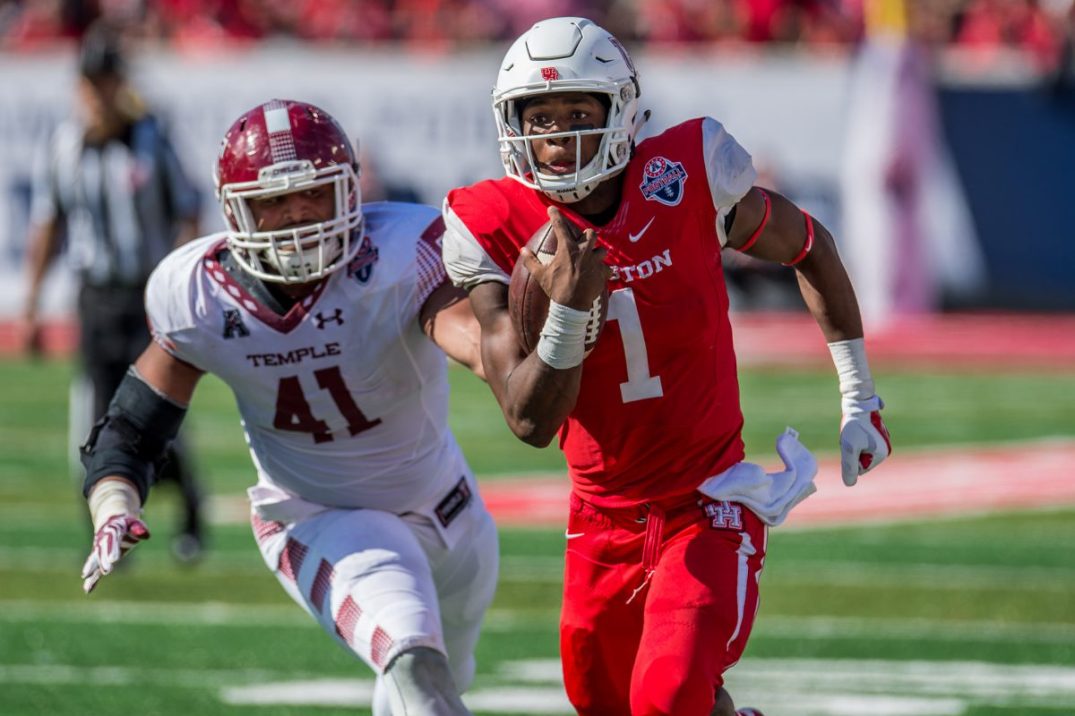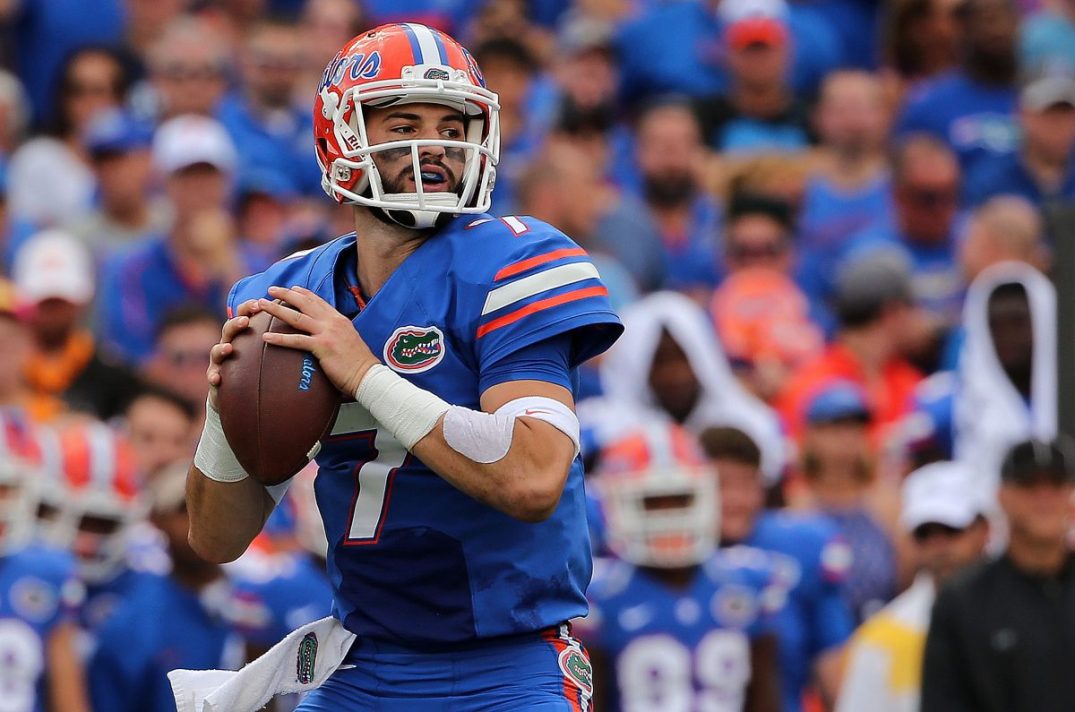By Dillon Durst
Follow @DillonDurst
2015 record: 8-5, 4-5 (Big 12)
Returning starters: 9 offense, 3 defense
West Virginia started last season 3-0, outscoring Georgia Southern, Liberty and Maryland, 130-23. Then, the Mountaineers dropped four straight to then-No. 15 Oklahoma (eventual Big 12 champs), then-No. 21 Oklahoma State, then-No. 2 Baylor and then-No. 5 TCU. Three of the four losses came on the road. But, West Virginia recovered, popping off four-straight wins over Texas Tech, Texas, Kansas and Iowa State. During the string of victories, the Mountaineers outscored opponents, 148-52. They suffered an embarrassing loss at Kansas State to end the regular season, but managed to beat Arizona State (6-7) in the Cactus Bowl, 43-42.
2016 projected starting lineup
Offense:
QB – Skyler Howard, Chris Chugunov or William Crest Jr.
RB – Rushel Shell, Justin Crawford and Kennedy McKoy
FB – Elijah Wellman, Michael Ferns, Alex Brooks
WR (X) – Shelton Gibson, Gary Jennings, Ricky Rogers
WR (Z) – Ka’Raun White, Jovon Durante, Marcus Simms
IR (Y) – Daikiel Shorts Jr., Devonte Mathis
TE – Stone Wolfley, Trevon Wesco
LT – Yodny Cajuste, Rob Dowdy
LG – Adam Pankey*, Grant Lingafelter
C – Tyler Orlosky, Jah’Shaun Seider
RG – Kyle Bosch or Tony Matteo
RT – Marcell Lazard, Colton McKivitz
Bold = returning starter
* = suspended for season opener
Senior Adam Pankey, a two-year starter, is suspended for the season opener against Mizzou after a DUI arrest on Aug. 14. Redshirt senior Tony Matteo, who’s played in 18 games and started two over the course of his career, will start in Pankey’s place at left guard.
The Mountaineers return a group of speedy, flashy receivers with big-play capabilities. Redshirt junior Shelton Gibson headlines the group, having hauled in 37 receptions last season for 887 yards and 9 touchdowns. He said this week he should’ve had over 1,500; he’s definitely capable. Daikiel Shorts (Sr.) is a reliable receiver on the inside, while Jovon Durante (Soph.) – if he can stay eligible and out of Dana Holgorsen’s doghouse – poses a serious downfield threat. Holgorsen and first-year receivers coach Tyron Carrier called sophomore Gary Jennings the team’s most dependable receiver, while Ka’Raun White (r-Jr.) has the size and physicality to live up to genetic expectations set by his record-setting brother, Kevin.
Rushel Shell (r-Sr.) is the clear-cut starter at running back, but Justin Crawford (Jr.), a JUCO-transfer, has been hyped up all offseason by the coaching staff. The speedy 6-foot, 200-pound back rushed for 1,610 yards and 16 touchdowns last year at Northwest Mississippi C.C., including 394 receiving yards. He was the No. 3-ranked JUCO back in the 2016 class.
Tyler Orlosky (r-Sr.), a 2015 All-Big 12 Second Team selection and two-year starter, will anchor the offensive line at center.
Skyler Howard (Sr.) returns at quarterback after passing for more than 3,000 yards last season, including 24 touchdowns to 14 interceptions. In the Mountaineers’ first three games of 2015, Howard passed for 916 yards and 9 touchdowns to just 1 interception. Give or take, those could be considered Heisman-caliber numbers – given the candidate and prior hype/expectations. But, in West Virginia’s four-consecutive losses at the hands of the Big 12’s upper echelon, Howard passed for 810 yards – the outlier being 289 against Baylor — and 7 touchdowns to 6 interceptions.
Kennedy McKoy, Marcus Simms and Steven Smothers are the true freshmen to be on the lookout for this season. Coaches have said McKoy will split time with Shell and Crawford at running back, while receivers Simms and Smothers have too much speed to keep off the field.
Bottom line: If the Mountaineers expect to contend for a Big 12 title this year, they NEED better play out of Howard against the conference’s upper tier. A team will only goes as far as its trigger-man takes it.
Defense (3-3-5):
DE – Noble Nwachukwu, Adam Shuler
NT – Darrien Howard, Alec Shriner
DE – Christian Brown, Jon Lewis
SAM – Justin Arndt, Xavier Preston*, Zach Sandwisch
MIKE – Al-Rasheed Benton, Hodari Christian, Logan Thimons
WILL – Sean Walters, David Long
SPUR – Marvin Gross Jr. or Kyzir White
FCB – Antonio Crawford, Nana Kyeremeh, Mike Daniels
FS – Jeremy Tyler, Toyous Avery
BS – Jarrod Harper
BCB – Rasul Douglas, Elijah Battle, Maurice Fleming
Bold = returning starter
* = suspended for season opener
West Virginia’s secondary took a hit when junior safety Dravon Askew-Henry, the team’s top returning tackler from last season, went down with a season-ending knee injury during fall camp. What’s more, promising freshman linebacker Brendan Ferns, a former 4-star recruit and the Mountaineers’ highest-rated prospect in their 2016 class, went down a few days later to a similar season-ending knee injury.
West Virginia loses its top 4 tackles – all linebackers – as well as versatile athlete and SPUR safety K.J. Dillon, along with cornerback Daryl Worley.
The DAWGS’ strength this year will most likely be along the defensive line. Noble Nwachukwu (r-Sr.), a 2016 Preseason All-Big 12 selection, is a two-year starter for the Mountaineers at defensive end, tallying 8.5 sacks and 4.5 tackles for loss in 2015. He will be their rock up front. Christian Brown, a 6-2, 305-pound redshirt senior, returns at the other defensive end spot after a 33-tackle, 4.5-tackle for loss 2015 campaign.
Three new starters take over at the strongside (SAM) middle (MIKE) and weakside (WILL) linebacker positions in third-year defensive coordinator Tony Gibson’s 3-3-5 scheme. Al-Rasheed Benton (r-Jr.) and Sean Walters (r-Sr.) are easily the most experienced, both having played in more than 26 games throughout their careers. Benton made one start last season against Liberty in Week 2, and finished the 2015 season with 21 tackles, including 4 tackles for loss. Redshirt senior Justin Arndt, who’s played all three linebacker positions throughout his career, reminds me way too much of former Mountaineer linebacker Wes Tonkery, who was undersized, but a tackling-machine nonetheless in 2014. Arndt, a 5-11, 215-pounder out of Martinsburg, W.Va., and Tonkery are the definition of a prototypical WVU football player, both being undersized, blue-collar, West Virginia-bred ‘backers. But, the bigger, more physical Xavier Preston (Jr.), who is suspended for the season opener, could take over starting duties in Week 2. The 6-2, 240-pound Preston has superstar potential, but has yet to fully harvest it. Marvin Gross (r-Jr.) could get the early nod at SPUR, a hybrid linebacker-safety position, but will more than likely give way to Kyzir White (Jr.), who’s been described as a flat-out stud. The 6-3, 221-pound White, brother of Kevin and Ka’Raun, was recruited out of Lackawanna C.C. in Pennsylvania specifically to play SPUR.
With Henry’s injury, senior Jeremy Tyler will get the nod at free safety. Tyler battled Henry for the starting free safety job prior to the start of the 2014 season, and has played in every game for the Mountaineers over the past two seasons. Redshirt senior Jarrod Harper will man the Bandit safety position, vacated by 1st-round NFL draft pick Karl Joseph. Harper, who’s played in 38 games with 9 starts, took over starting duties last season in Week 5 after Joseph went down with a season-ending knee injury. At cornerback, Rasul Douglas (r-Sr.), a rangy former JUCO-transfer, and Antonio Crawford, a graduate transfer from Miami (Fla.), are listed as the starters at the boundary and field cornerback positions, respectively. But, Maurice Fleming, another graduate transfer from Iowa, Nana Kyeremeh (r-Sr.), Elijah Battle (Jr.) and Mike Daniels (Jr.) will all play.
Bottom line: The Mountaineers boast a slew of veteran starters and depth players. If the unit can stay healthy, I look for it to improve as the season progresses, much like it did in 2014.
Special teams:
K: Mike Molina, Josh Lambert*
P: Billy Kinney, Jonn Young
LS: Nick Meadows, RC Brunstetter
H: Billy Kinney, Jonn Young
KO: Mike Molina, Billy Kinney
PR: Gary Jennings
KR: Shelton Gibson, Gary Jennings
Schedule breakdown:
West Virginia has a good chance to start the season 4-0. It gets Mizzou, Youngstown State and Kansas State at home, and a Week 3 bye gives the Mountaineers an extra week to prepare for BYU, a team notorious for putting up big offensive numbers, in D.C.
The ‘Eers are a more talented team than Kansas State, but will need to play exceptional run defense and take care of the ball if they expect to beat the Wildcats for the first time since joining the Big 12 in 2012.
West Virginia gets a Week 6 bye to prepare for a road trip to Texas Tech, what I consider a swing game. Red Raiders quarterback Patrick Mahomes (4,653 yds, 36 TDs, 15 INTs in 2015) figures to be a Heisman darkhorse this season, so the Mountaineers will need to be able to run the ball and play keep-away.
From there, a gauntlet of 7-consecutive conference games follow. West Virginia gets TCU at home in Week 8, but plays Oklahoma State on the road the following week.
The Mountaineers should get an easy home win over Kansas in Week 10, but will be tested by what should be a very good Texas defense the following week in Austin, Texas.
By this time, too, attrition will inevitably begin to set in. The best teams in the nation are the ones that are built to last, and while West Virginia is a veteran-laden team, an injury to Howard or safeties Tyler or Harper could prove to be costly. The Mountaineers final two games against Iowa State (on the road) and Baylor (at home) are both winnable.
Bottom line: I think anything from 5-7 to 9-3 is possible. I’d gauge the most realistic number of wins at 7, given the conference gauntlet and the attrition variable. But, Howard’s play – good or bad – will effect that number. He started last season with Heisman-caliber numbers, but faltered against tougher opponents. If Year 2 is indeed Skyler Howard’s year, 9 wins is very possible. He has the luxury of having two – possibly three – quality backs to lean on, so his primary concern should be not turning the ball over. But, the Mountaineers will almost inevitably lose a game at some point during that conference stretch from October to December. It’ll be how Howard – and the rest of the team – bounce back from the loss(es) that will depend on whether West Virginia plays in a New Year’s Day bowl or sends Holgorsen packing. Another 7-win year might buy Holgorsen another year, but 6 will not. The sixth-year head coach has two years remaining on a six-year contract extension he signed in 2012.



